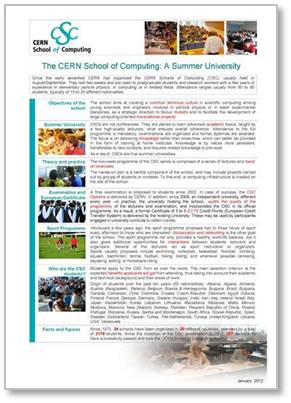 |
|
|
|||||||
|
The CERN Schools of computing in a nutshel Since the early seventies CERN has organized the CERN Schools of Computing (CSCs), usually held in August/September. They are open to postgraduate students and research workers, working at CERN or at external institutes, with a few years of experience in elementary particle physics, in computing or in related fields.
The participants come mainly from the CERN Member States or from laboratories in countries associated with CERN. However, a fraction of the students come from outside the particle physics community, generally attracted by the advanced topics that are taught. Attendance ranges from 60 to 80 students, typically of 15 to 30 different nationalities.
The schools last two weeks, and are generally organized
on the campus of a university or in a hotel with close networking connections to
a university or laboratory. |
|||||||
|
Overall objectives of the School The school aims at creating a common technical culture in scientific computing among young scientists and engineers involved in particle physics or in sister experimental disciplines, as a strategic direction to favour mobility and to facilitate the development of large computing-oriented transnational projects. A summer university CSCs are not conferences. They are places to learn advanced academic topics, taught by a few high-quality lecturers, what ensures overall coherence. Attendance to the full programme is mandatory, examinations are organized and formal diplomas are awarded. The focus is on delivering knowledge rather than know-how, which can better be provided in the form of training at home institutes. Knowledge is by nature more persistent, transferable to new contexts, and requires related knowledge to pre-exist.. As a result, CSCs are true summer universities Theory and Practice
The two-week programme of the CSC series is comprised of a series of lectures
and
hand-on exercises
The hands-on part is a central component of the school, and may include projects carried out by groups of students or contests. To this end, a computing infrastructure is created on the site of the school. Examination and European Certificate Since 2002, CSC offers a CSC diploma upon a successful completion of an optional exam.
In addition, since 2008, the university hosting the CSC,
assures the quality of the syllabus
and incorporates the CSC in its official teaching programme.
As a result, a formal Certificate of 5 to 6
ECTS Credit Points (European Credit Transfer System)
is awarded by the hosting University. Sport programme Introduced a few years ago, the sport programme offers two to three hours of sport every afternoon to those who are interested. Socialization and networking is the other goal of the school.
The sport programme not only
provides a healthy work-life balance, but it also gives additional opportunities
for interactions between students,
lecturers and organizers. Several of the lecturers act as sport instructors or
organizers. Specific objectives of the School
The CERN Schools of Computing have two
specific objectives in terms of education and knowledge transfer:
Format of the School
|
|||||||
|
|
